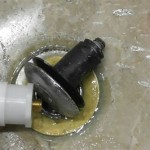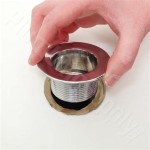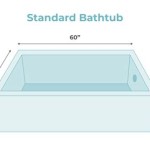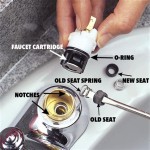How to Repair a Bathtub Drain Plug
A bathtub drain plug is a simple, yet essential component of any bathroom. It allows you to fill the tub with water for a relaxing soak, and then easily drain the water when you're finished. However, over time, the drain plug can become worn, damaged, or simply stop working properly. This can be a frustrating problem, but fortunately, it's often a simple fix that can be tackled by most homeowners with basic tools and a little know-how.
Identifying the Problem
Before you start repairing your bathtub drain plug, it's important to identify the specific problem. This will determine the best course of action for repair. Here are a few common issues:
- Leaky plug: If the drain plug leaks water even when it's closed, the problem is likely a worn-out seal or a loose fitting.
- Stuck plug: If the drain plug is stuck in either the open or closed position, it's likely due to corrosion, debris build-up, or a broken lifting mechanism.
- Missing or broken parts: If the plug is missing entirely, or if parts like the lift rod or stopper are broken, you'll need to replace the entire drain plug.
Repairing a Leaky or Stuck Drain Plug
For a leaky or stuck drain plug, there are a few simple solutions you can try:
1. Tightening the Plug
If the plug is loose, simply tightening it might resolve the issue. Locate the nut or screw that secures the drain plug to the drain assembly. Use an appropriate wrench or pliers to gently tighten the nut. Be careful not to overtighten it, as you could damage the threads or break the drain assembly.
2. Cleaning the Drain
A buildup of hair, soap scum, and other debris can prevent the drain plug from functioning properly. You can clean the drain with a drain cleaner or by using a combination of baking soda and vinegar.
To use a drain cleaner, follow the product instructions carefully, paying attention to safety precautions like using gloves and ensuring proper ventilation. To use baking soda and vinegar, pour a cup of baking soda down the drain, followed by a cup of vinegar. Allow the mixture to fizz for about 30 minutes, then flush with hot water.
3. Replacing the Seal
If the plug is leaking, it's possible the seal is worn out. This is a common problem, especially for older drain plugs. The seal can be replaced with a new one, which can be purchased at most hardware stores. To replace the seal, you'll need to remove the drain plug, remove the old seal, and then install the new seal. The process for removing and installing the seal can vary depending on the type of drain plug you have. It's helpful to consult a guide for your specific drain plug model.
Replacing a Bathtub Drain Plug
If the drain plug is beyond repair, or if parts are missing, you'll need to replace it entirely. Replacing a bathtub drain plug is a relatively straightforward task that can be done by most homeowners. Here's a general overview of the process:
1. Gather the Necessary Tools and Materials
Before you begin, ensure you have the following:
- A new bathtub drain plug that fits your drain
- A wrench or pliers
- A screwdriver (may be needed for certain drain plug types)
- Optional: A drain cleaning tool (optional)
2. Remove the Old Drain Plug
First, remove the old drain plug. This can be done by unscrewing the plug or by using a wrench to loosen the nut that holds the plug in place. If the plug is stuck, try using a drain cleaning tool to remove any debris or corrosion that may be preventing it from coming out. Once the plug is out, remove the old seal and any other old parts.
3. Install the New Drain Plug
Clean the drain assembly and surrounding area. Place the new drain plug into the drain opening and ensure it sits flush with the drain hole. Tighten the securing nut or screw with a wrench or pliers. If the drain plug has a lift rod, make sure the rod is properly connected and that the plug can be easily lifted and lowered.
4. Test the New Plug
After installing the new plug, fill the bathtub with water to test its functionality. Ensure the drain plug seals properly and that there are no leaks. If the drain plug still leaks, check that the drain is properly sealed, ensure the plug is fully seated, and that the nut is tightened securely. If necessary, remove the new drain plug and inspect it to ensure it's not damaged. If the leak persists, it's best to call a plumber to resolve the issue.
Repairing or replacing a bathtub drain plug is a simple task that can help to prevent plumbing issues and save you money in the long run. By following these steps, you can effectively troubleshoot and fix a broken bathtub drain plug. However, remember that if you encounter any difficulty or have any doubts, don't hesitate to contact a qualified plumber for professional assistance.

Easy Replacement Of A Bathtub Drain

Replacing A Tub Drain Bathtub Removal And Replacement

How To Remove A Bathtub Drain The Home Depot

How To Remove A Bathtub Drain Stopper

How To Replace Bathtub Drain Stopper With A Lift And Turn Diy

Bathroom Repair How To A Pop Up Tub Drain Stopper

How To Remove A Bathtub Drain The Home Depot

Diy How To Replace A Bathtub Drain Stopper With Common Household Tools

Trouble Removing Lift And Turn Bathtub Stopper R Fixit

Bathtub Drain Stopper Sink Tub Plug Universal Bathroom Bath Stoppers Shower Cover Replacement Jets Hair Catcher Topper Rubber Strainers Patented Yahoo Ping








